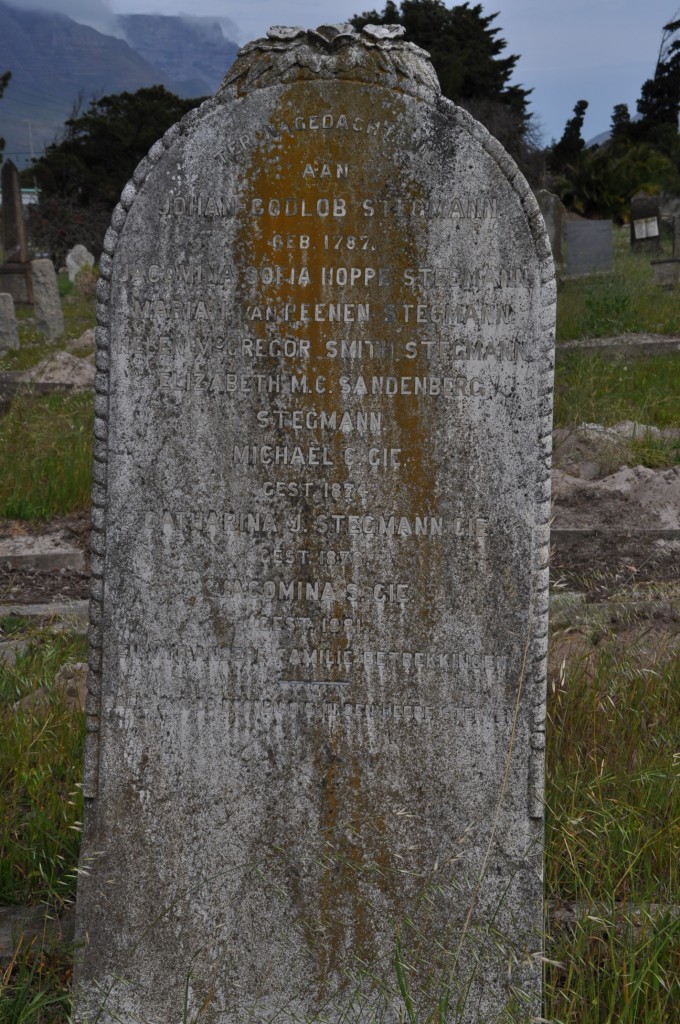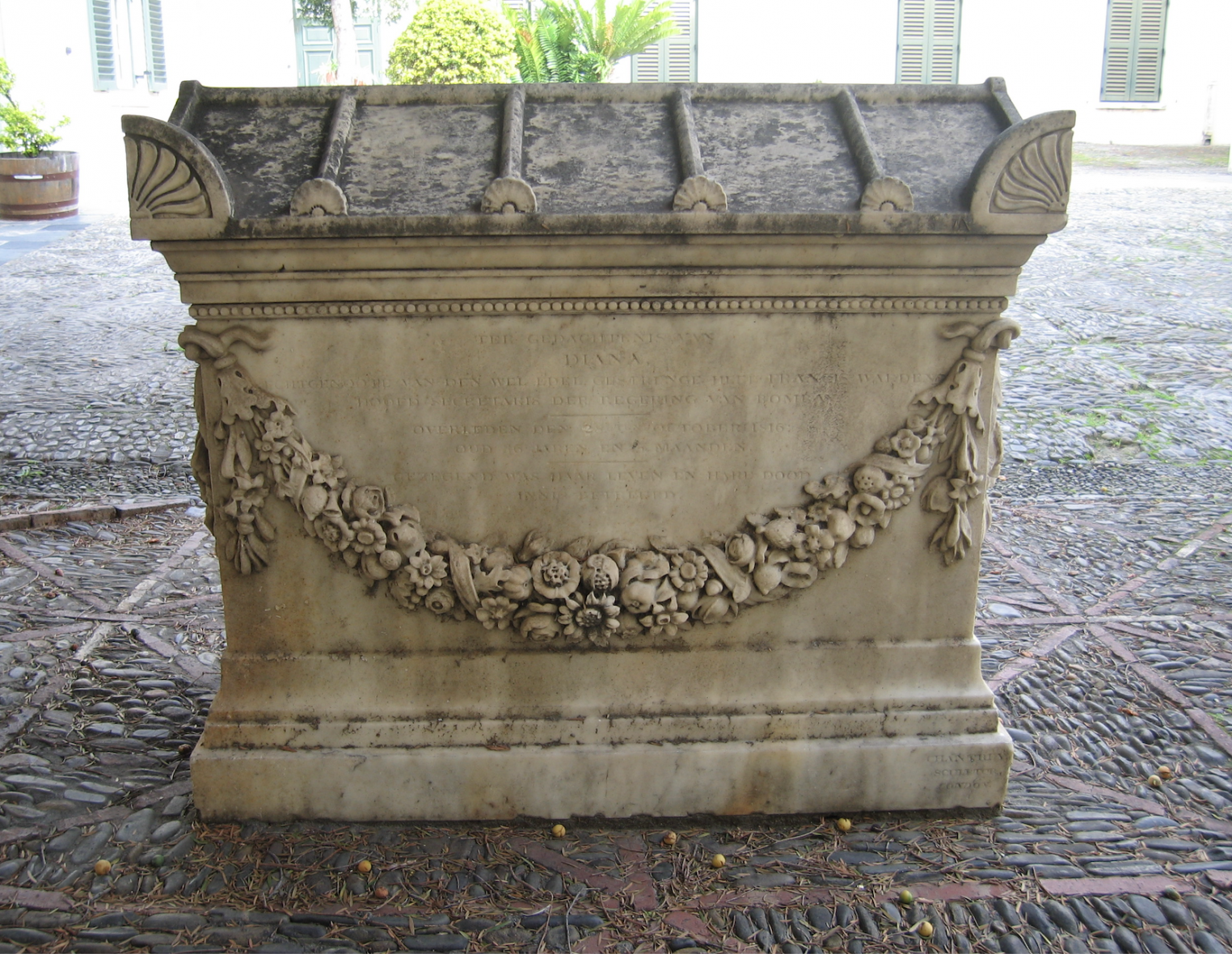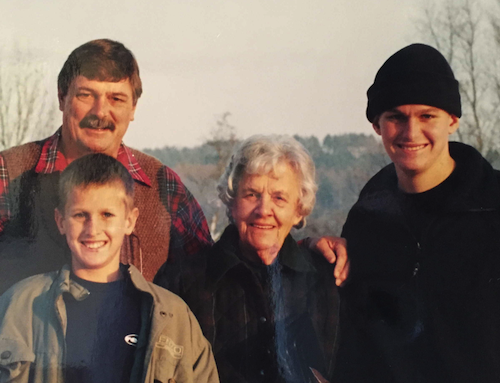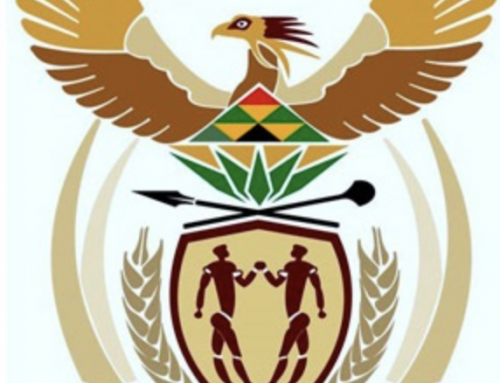
Johan Goblob Stegmann was born 1787, Jacomina Sofia Hoppe Stegmann, Maria I. van Reenen Stegmann, Helen McGregor Smith Stegmann, Elizabeth M. C. Sandenberg Stegmann, Michael C. Gie died 1874 also Catharina J. Stegmann Gie died 1876, Jacomina S Gie died 1881
Tombstones can be valuable historical records. In some instances printed works give more than one date for a person’s death. A more reliable original authority, better even than a burial register, is often to be found in the grave inscription. Moreover, these often supply information not readily available elsewhere. A stone at Maitland Cemetery, Cape Town, for example, shows that the Collisons (who played a leading role in the city’s wine trade for so long a period) came from Armagh in Ireland. A second tells us that the Lawtons, another important Cape family, hailed from Stalham in Norfolk. Stones at St. George’s Cathedral reveal that S. S. Bailey fought at Trafalgar and Isaac Manuel for Napoleon at Austerlitz. Dates of birth, too, which could otherwise often be obtained only by search of registers from overseas are sometimes conveniently recorded on tombstones.
The Historical Monuments Commission (now known as the South African Heritage Resources Agency) has recognised their value by proclaiming a number of them. The stone of Johann van Riebeeck deservedly received detailed notice in this journal and the Africana Museum possesses at least one tombstone. Two welcome efforts to preserve historic cemeteries have been initiated in 1968: the War Graves Commission has undertaken to restore Simon’s Town cemetery, which is historically the most valuable in South Africa, and the Roman Catholic authorities plan to move to Maitland all the graves and slabs at Rouwkoop Road, Rondebosch. Among the most interesting tombs here is that of the father of Sir Percy Fitzpatrick and one of Sir Percy’s daughters.
It is, therefore, particularly tragic that this attitude did not exist when Somerset Road, Cape Town, which was much the largest and most important cemetery in this country, was closed down and many valuable stones were destroyed. There were not far short of a dozen cemeteries in the area. Some were for the burial of non-Europeans, hospital patients, and the like, and probably few of their graves had inscribed stones, but others were of considerable extent and had stones commemorating South Africans of early date and historical importance. The Dutch Reformed Church Congregation had at first used their church in the Heerengracht and its yard and, happily, some of these valuable early stones are preserved at the present Groote Kerk. A grant of land at what was later Somerset Road was made in 1755 and further grants in 1801 and 1802. The Anglicans received a grant in 1827, the Lutherans in 1833, the Scottish Church, and the Roman Catholics, soon after. Some denominations did not have a separate cemetery but may have had portions of the Anglican allotted to them. The whole group was finally closed in January 1886. At that time there was no question of building over the site or destruction of the tombs and the families of the deceased continued to erect memorials up to the time of closure. In the Anglican cemetery alone there were as many as 160 burials in a year and, when one recalls that burials took place in this area for over a hundred years, it can be realised that the number of inscribed stones must have run into thousands.
When it was decided to build over the site frequent notices appeared in the Press that families could remove the remains and the monuments of ancestors and inter them elsewhere and a number of families did so. Understandably, the tombs that remained behind were neglected and suffered damage from vandalism and from encroaching vegetation. In December 1903 there was even a fire, possibly first lit by vagrants who used to camp in the deserted vaults and easily spreading to the bushes and long grass that now covered the area. Before leveling and building started in about 1922 a number of inscribed stones were lifted from their graves and deposited at the Woltemade cemetery at Maitland which had been opened as Cape Town’s principal graveyard in 1886. Before making an assessment of what was lost mention can be made of what was saved.
Entire Graves Moved to Maitland
Lt.-Colonel C. Graham Botha made notes in Somerset Road in 1907 and quoted from these in two articles published at a later date. He listed eight complete tombs which had been moved to Maitland and to these I can add a further thirty-four. The majority commemorate persons who died quite shortly before the closure and therefore had relatives to arrange transfer. Only the most important need be mentioned here.
The earliest is that of the Colonial Secretary Andrew Barnard (1807). His wife Lady Anne Barnard had the slab sent out from Britain. The earliest British tombs were set up in the Dutch cemeteries as there were no others and often had inscriptions in both English and Dutch: such was the case on this tomb and the next to be described.
The next in date is also, to my mind, the most beautiful churchyard monument in the country and we must be thankful that it has survived when so much else has perished. A marble sarcophagus with fine foliage carvings and a medallion portrait of the deceased preserves the memory of Diana, wife of Francis Warden of the Bombay Civil Service (1816). The lady died in Cape Town and was one of the many folk who died on their way to or from India or of illnesses contracted in India. The memorial is signed by Sir Francis Chantrey, the foremost English sculptor of his day.
A modern monument has arisen to many members of the Hohne family, beginning with Christian Gottlob Hohne (1759-1820) who was Private Secretary to four Governors of the Dutch East India Company and Director of the Slave Lodge.
Not far away are the stones of John Fairbairn (1864), the sturdy fighter for the freedom of the Press, of his wife Elizabeth (1840) who was a daughter of Dr. John Philip, and other members of the Fairbairn and Philip families.
There is a stone for Alexander Jardine (1845) the first Librarian of the South African Library. Nearby is a stone that commemorates an unfortunate accident of 1860 when Edward Turpin, who had been captain of the Volunteer Cavalry Corps since its foundation in 1857, died ” from the effects of a gun-shot wound received at the Colonel-in-chief’s drill on the Parade.”

Here lie the remains of William George Parker who departed this life on the 8th of April 1878 aged 49 years and Annie 6 months also Johanna Frederica Parker 3rd daughter of the above departed on 9th November 1878 aged 16 years & 4 months
A tall stone obelisk commemorates Lady Sale (1853) wife of Sir Robert Sale, the hero of many British campaigns but best known as the conqueror of Afghanistan in 1839. Lady Sale died only three days after landing from India but the South African Advertiser paid her the compliment (unusual in those days) of quite a long obituary and reported that ” her funeral was followed by His Honour the Lieutenant-Governor, the Commodore, the Heads of Departments, besides a large number of the principal inhabitants of Cape Town.” The obelisk was made in Calcutta, to the order of her children who composed the touching epitaph which begins: “under this stone reposes all that could die of Lady Sale … ”
A stone slab on a table tomb recalls one of the Cape’s earliest climbing fatalities when Edwin Gregory ” perished from cold on Table Mountain ” in June 1858 – which seems a very unwise time of the year to go mountaineering.
Finally, one should not omit the Rev. James Adamson (1875), the earliest minister of the Scottish Church in Cape Town and one of the Cape’s leading educationists.
Entire Graves Moved Elsewhere
The slate slab of James Miller in Mowbray Anglican cemetery is dated 1831, which was long before that cemetery was opened and suggests the grave came from Somerset Road.
Colonel Botha records a slab of Captain A. C. Campbell of the Bengal Cavalry (1845) at Somerset Road. If he is correct this was evidently moved after 1907 as it is now at St. Paul’s, Rondebosch.
St. Saviour’s churchyard at Claremont contains the stone of John Inglesby (1823), late of the Royal Artillery. He was the progenitor of several men who became well-known architects and builders and it was they who moved his grave to their family vaults at Claremont.
In the old cemetery at Wynberg are the graves of Major Richard Wolfe (1855) and his wife Anna Maria (1837). Wolfe had been Commander of Robben Island and Magistrate of Wynberg but was first buried at Somerset Road 3 alongside his wife.
The remains of the Van de Poel (sic) and Hiddingh families were moved from Somerset Road and re-interred in the cemetery at Mowbray on 25 August 1894 but without the original gravestones.
Inscribed Stones Moved to Maitland
The list kindly supplied to me by the Cape Cemeteries Board shows that 455 slabs were moved to Maitland. Of these, I found only 270 when I made a census in January 1964, with a further five unlisted there. Thirteen of the 275 were moved to the South African Museum (Cultural History) in July 1964 (see below). Most of the surviving 262 are of interest in one way or another but only a few can be mentioned here.
The top part of a slab of 1834 which contained the person’s name is, unfortunately, missing. But the lower portion says he was the founder of the South African Assurance Company-which was the earliest such company in this country. The man concerned is presumably Thomas Le Breton who was its secretary when it was founded in 1831.
The stone of James John Arshut (1853) is interesting in several ways. Arshut was a Chinese who lived in Barrack Street and was a member of the Anglican Church. He must have been one of the country’s earliest Chinese and about the first Chinese Anglican. He is the only non-European to have a slab at Maitland and must have been one of exceedingly few to be buried in a European cemetery at Somerset Road. Part of the inscription is in Chinese – which does not appear elsewhere. Chinese, incidentally, is only one out of many languages to grace these slabs. Though most are in English and a good many are in Dutch there are several in Latin and two in Greek.
Inscribed Stones Moved to the South African Museum
In 1964 I drew the attention of Dr. J. van der Meulen, the then Museum Director, to the Maitland stones. The Cemeteries Board gave us permission to remove any stones we wished. The director, some of the Museum staff, and I, visited Maitland on 22 July. Some twenty stones were selected as of especial value and marks were placed on them. Thirteen were at once removed to the Museum, the intention being to add the others later. Seven of the thirteen have been set into the walls of the inner courtyard near the Van Riebeeck stones.
1. Hans Derik Mohr 1720-1785. One of the earliest inscribed stones in this country.
2. George Friedrich Hennigen. Born at Hirschberg in 1741, died 1797.
3. Christiaan Arnold Hohne 1793-1811. Clerk of the Colonial Secretary’s office and Collector of Stamps.
4. Johannes Andries Bain 1744-1818.
5. Christiaan Frederik Germann. Born Hamburg 1739, died 1819.
6. Jane Bowler (1849), wife of the famous artist, and their daughter Maria (1881).
7. Thomas Paine Bide (1865), Assistant Port Captain, and three relatives.
The present director does not favour the erection of further slabs and the other six remain in storage. Of these the stone of Helen Watson (1812) is one of the earlier known British stones; and Samuel Oliver (1785-1859) was a man of some note, a member of the East India Company and one of the earliest trustees and churchwardens of St. George’s church. Seven marked stones have not yet been moved from Maitland.

Sacred to the Memory of Margaret Annie beloved wife of John Stonier died 14 May 1869 aged 31 years. And her soul went down while it was still day.
Inscribed Stones Moved Elsewhere
Congregational Church, Rondebosch : Dr. Johannes Theodorus Van der kemp (1811), this slab tells us that he studied at Leyden and Edinburgh universities, wrote theological works in Latin and Dutch and was twelve years a missionary ” among the Caffres and Hottentots.” His headstone is now kept for posterity at the Rondebosch Congregational Church.
St. George’s Cathedral: Isaac Manuel (1845), a pioneer in the export of hides from South Africa to Europe.
St. George’s Cathedral: Dr. Samuel Bailey (1864), the founder, and for long the chief surgeon, of the Somerset Hospital.
Metropolitan Methodist Church, Cape Town : Rev. Barnabas Shaw (1857), founder of the Methodist mission in South Africa.
Kirstenbosch : I was able to arrange in 1968 for the stone of Dr. Ludwig Pappe (1862), first holder of the post of Colonial Botanist and first professor of botany at the South African College, to be handed over to the National Botanical Society. It is now in the Compton Herbarium.
Monuments Lost at Somerset Road
It is impossible to calculate how many monuments were left behind at Somerset Road and destroyed. A number of those noted by Colonel Botha in 1907 as of early date or historical interest are no longer in evidence :
Susanna, wife of John Claiden, Provost Marshal (1799).
Captain Charles Mackenzie, 74th Regiment (1800).
Margaret, wife of Major S. D. Dalrymple, Madras Artillery (1809).
Elizabeth, wife of Major-General F. A. Wetherell (1809). A slab of 1811, one of 1812 and two of 1813.
John Pringle, Agent of the East India Company (1815).
Deborah, widow of Major R. Coxon, 1st Ceylon Regiment (1819).
Lt.-Colonel John Graham (1821), the founder of Grahamstown. A window was erected to his memory in St. Saviour’s, Claremont, in about 1931. If there were people interested in him as late as that there seems to be a hope that his tombstone also has been saved but I have not managed to trace it.
Joseph Luson (1822), Agent to the East India Company.
To the above list I can add the names of a few other persons of historical importance. Nearly all these are known to have had tombs at Somerset Road and the remainder can quite safely be assumed to have had them. I am sure this list could be greatly extended, especially in the Dutch section.
Louis Thibault (1815): the great architect. Arthur Elliott photographed the stone in or soon after 1900. In the published list of Elliott’s photographs the exact position of the stone, in what is now Lower Buitengracht, is given.’ The loss is all the more grievous because the slab was carved by his great friend Anton Anreith.” We are told that when Thibault died Anreith was ” so affected by the occurrence that he carved the name Thiboult instead of Thibault.”
Anton Anreith (1821): the sculptor. His tomb is said to have been either in the military or in the Dutch’ cemetery.
Ellen Maria Warden : wife of John Warden of the Bombay Civil Service (1829). Her husband ordered a tablet which was carved by the leading English sculptor. This tombstone was moved to Maitland and then back to Iziko Museum at the top of Adderley Street where it remains today. It is also known as “The Chantrey Marble”

Grave of Diana Warden
John Bacon the Younger. As the Anglican church had not yet been built the tablet was placed on her tomb.
William Wilberforce Bird (1836): Bird was a cousin of William Wilberforce and, after being Whig member of parliament for Coventry, he was in charge of released slaves at the Cape and later Controller of Customs.
Lady D’Urban (1845): wife of the former Cape Governor Sir Benjamin D’Urban.
Baron von Ludwig (1847): leading citizen and founder of one of the first botanic gardens.
Hamilton Ross (1853) : Ross, in his younger days a friend of the Duke of Wellington, left the Army and became one of the earliest English merchants in Cape Town and presently one of its most important. He was also an early member of the Cape Legislative Council.
Sir John Wylde (1859): Chief Justice.
Andrew Geddes Bain: the road builder (1864). His burial is shown in the register of St. George’s Cathedral but Mrs. Lister remembered his large tombstone as being in the Scottish cemetery. It was enclosed in an iron railing and purple verbena grew thickly round it.’ Mr. I. Mitford-Barberton says that Bain’s remains were moved to Maitland but I have been unable to trace the stone.
References
Article by R. Rau in Africana Notes and News, September 1967, vol. 17, No. 7, p. 308.
Genealogists’ Magazine, March 1950 and 1951.
Burials register of St. George’s Cathedral, Cape Town. 19 December 1811.
Eric Rosenthal’s S.A. Dictionary of National Biography gives year of death as 1812. A brass plate below the slab explains that it was moved from the Dutch cemetery at Somerset Road in September 1907.
The Cape-quaint and beautiful, by Victor de Kock, Cape Town, Citadel Press, 1938.
Anton Anreith, by C. de Bosdari, Cape Town, Balkema, 1954.
South Africa through the Centuries, by W. R. Morrison, Cape Town, Miller, 1930.
Reminiscences of Georgina Lister, Johannesburg, Africana Museum, 1960.





